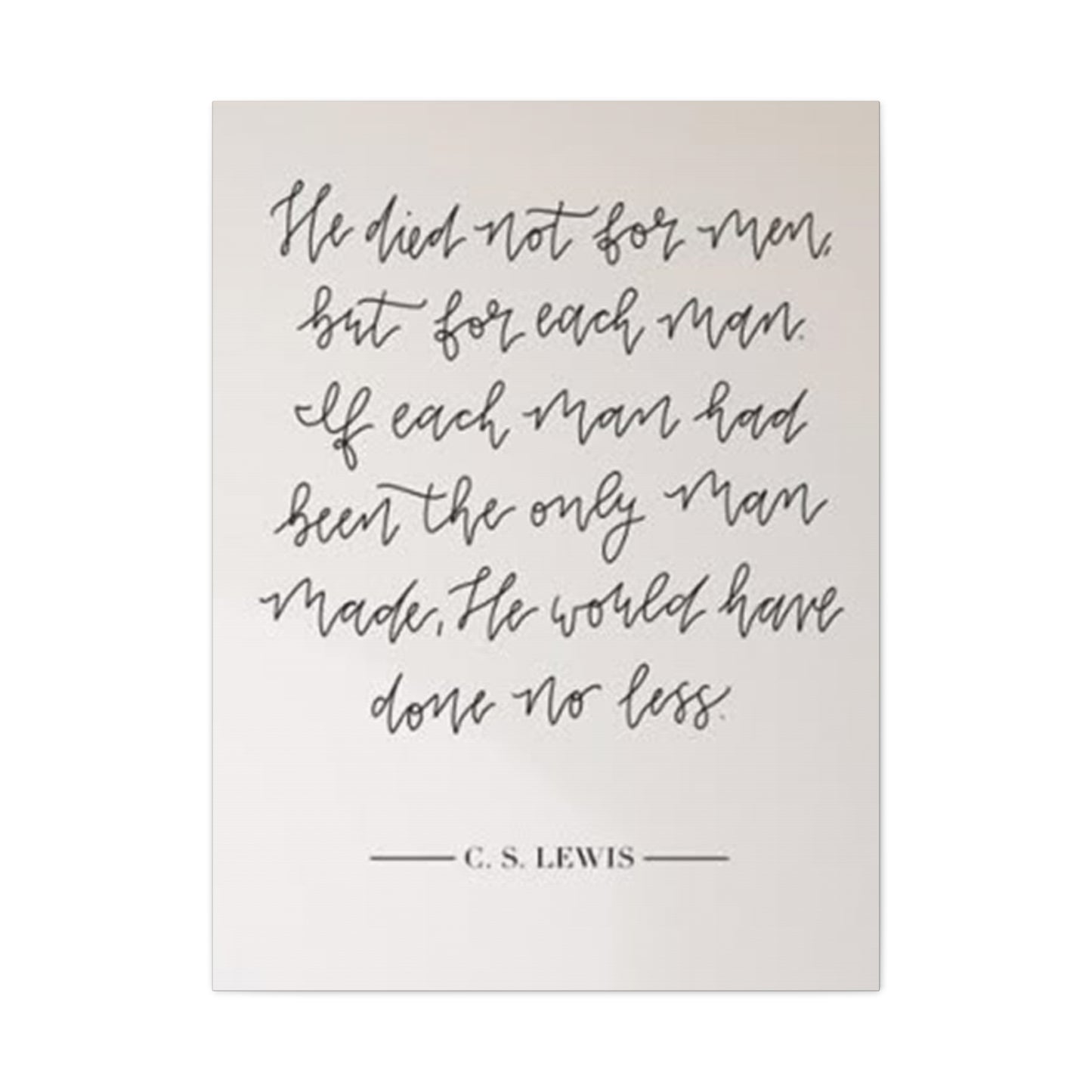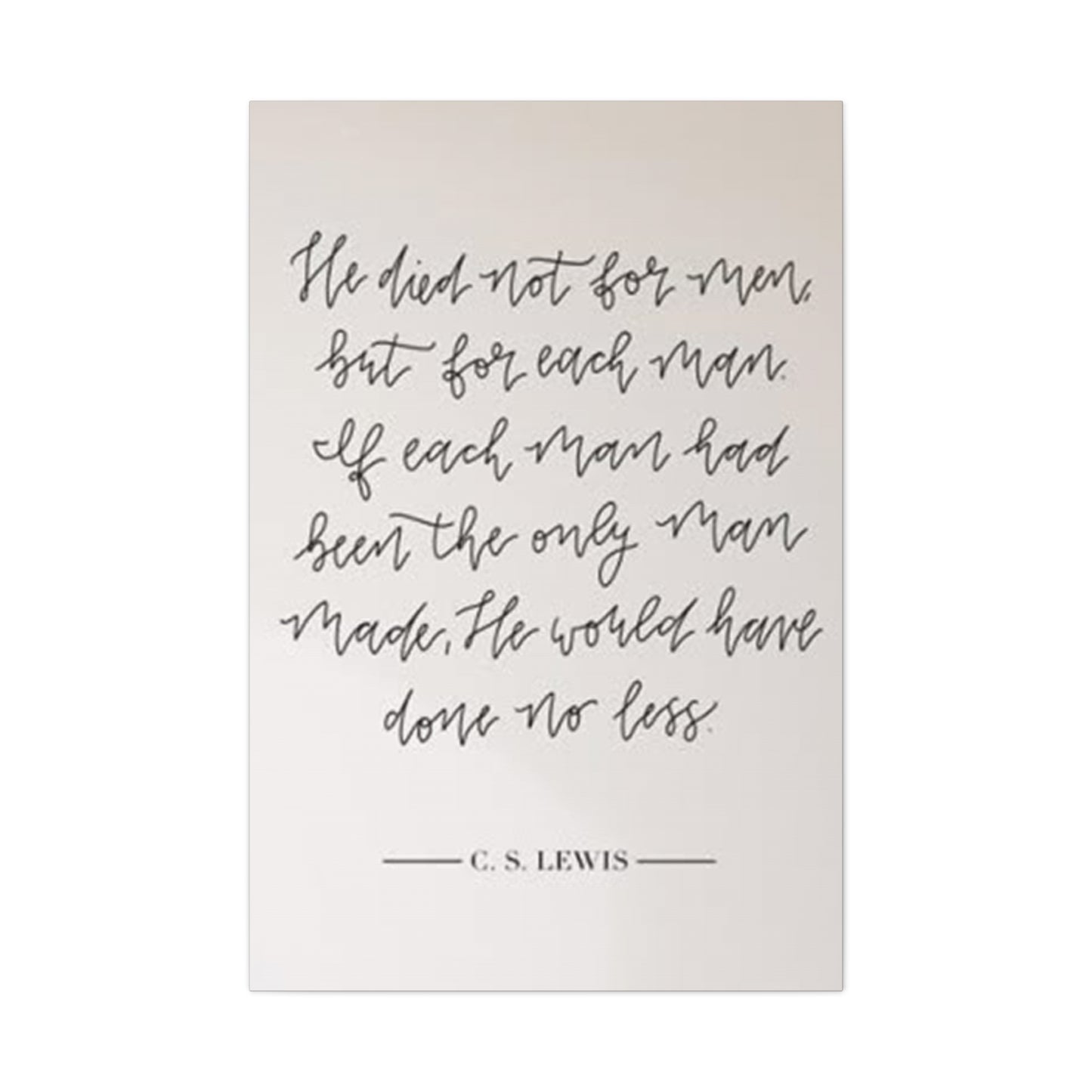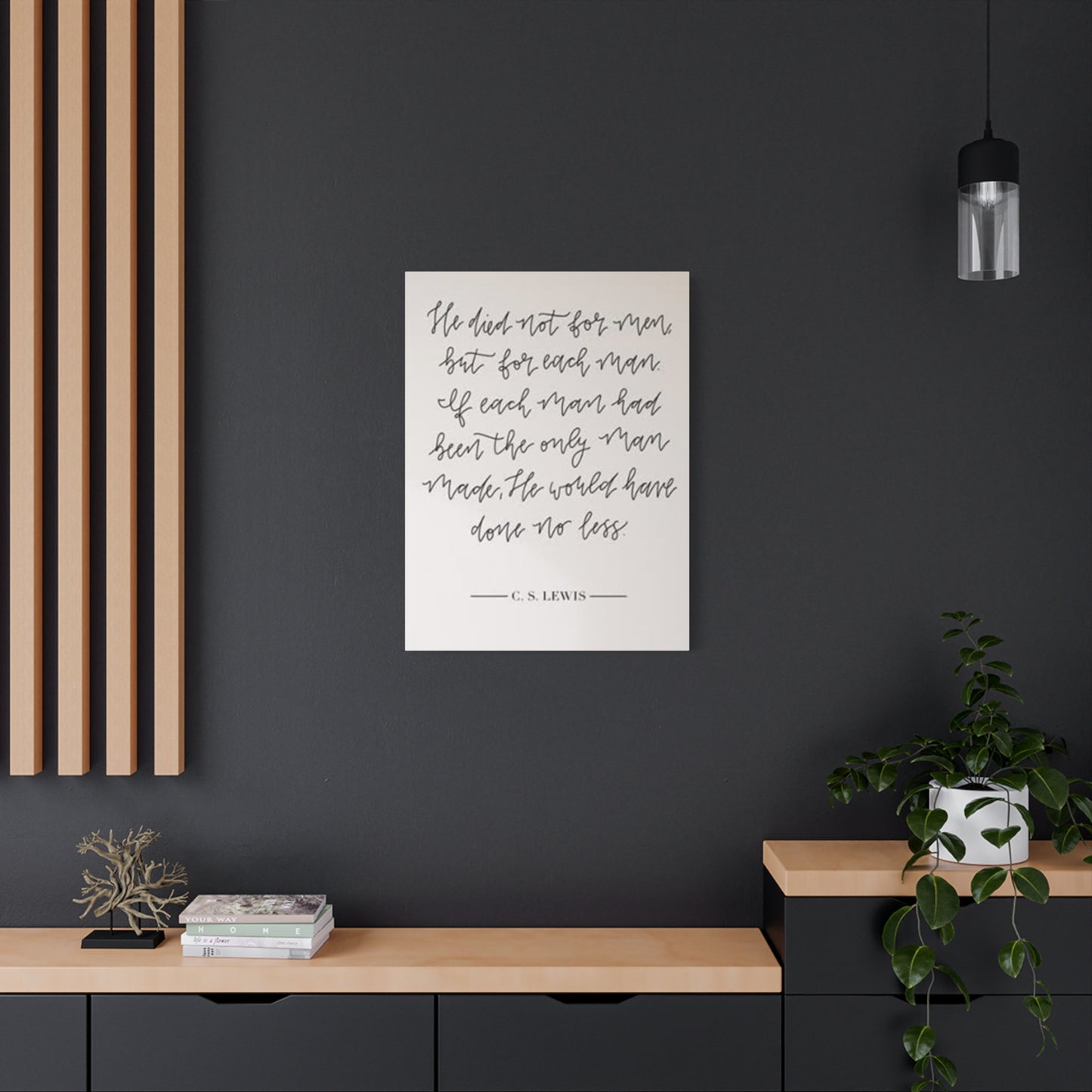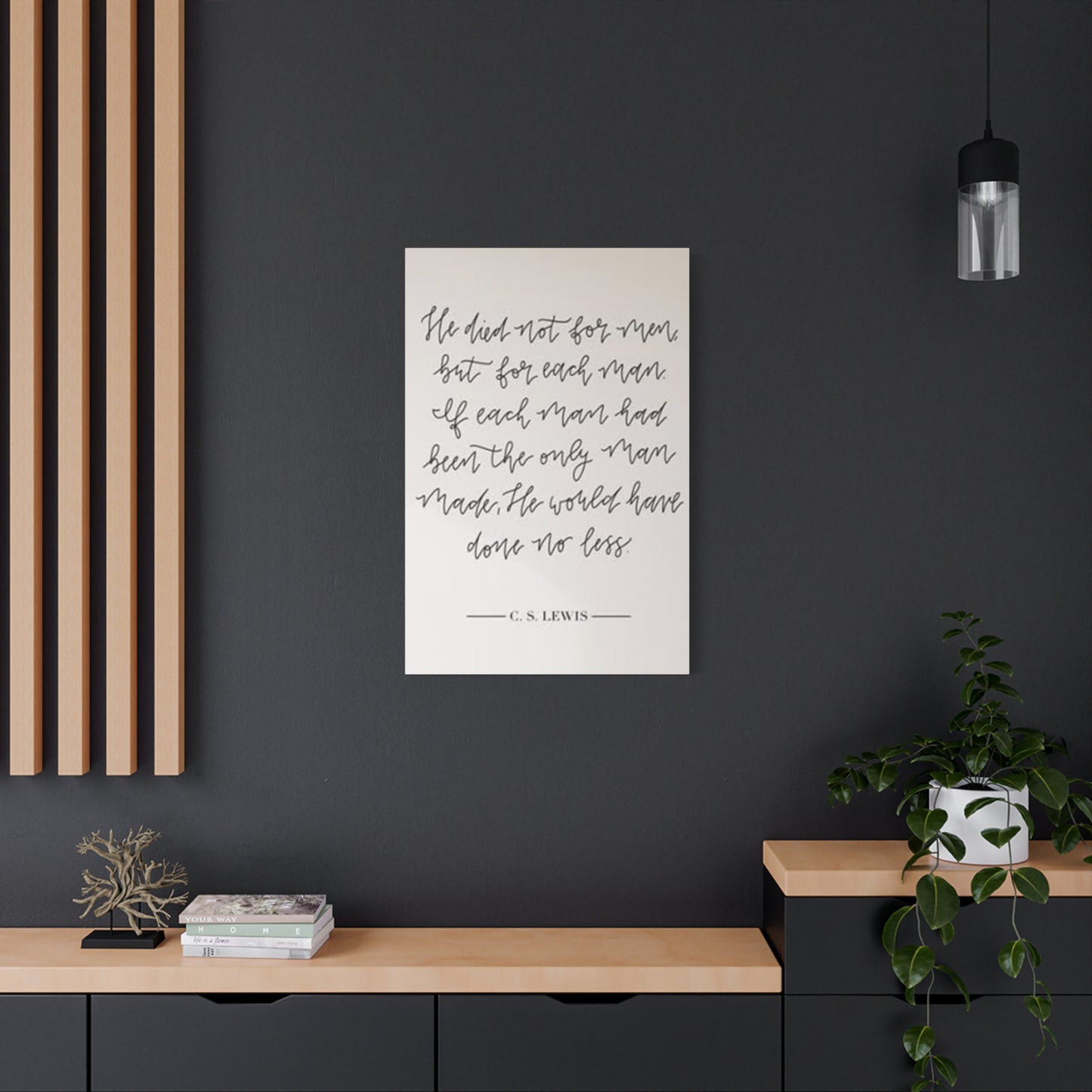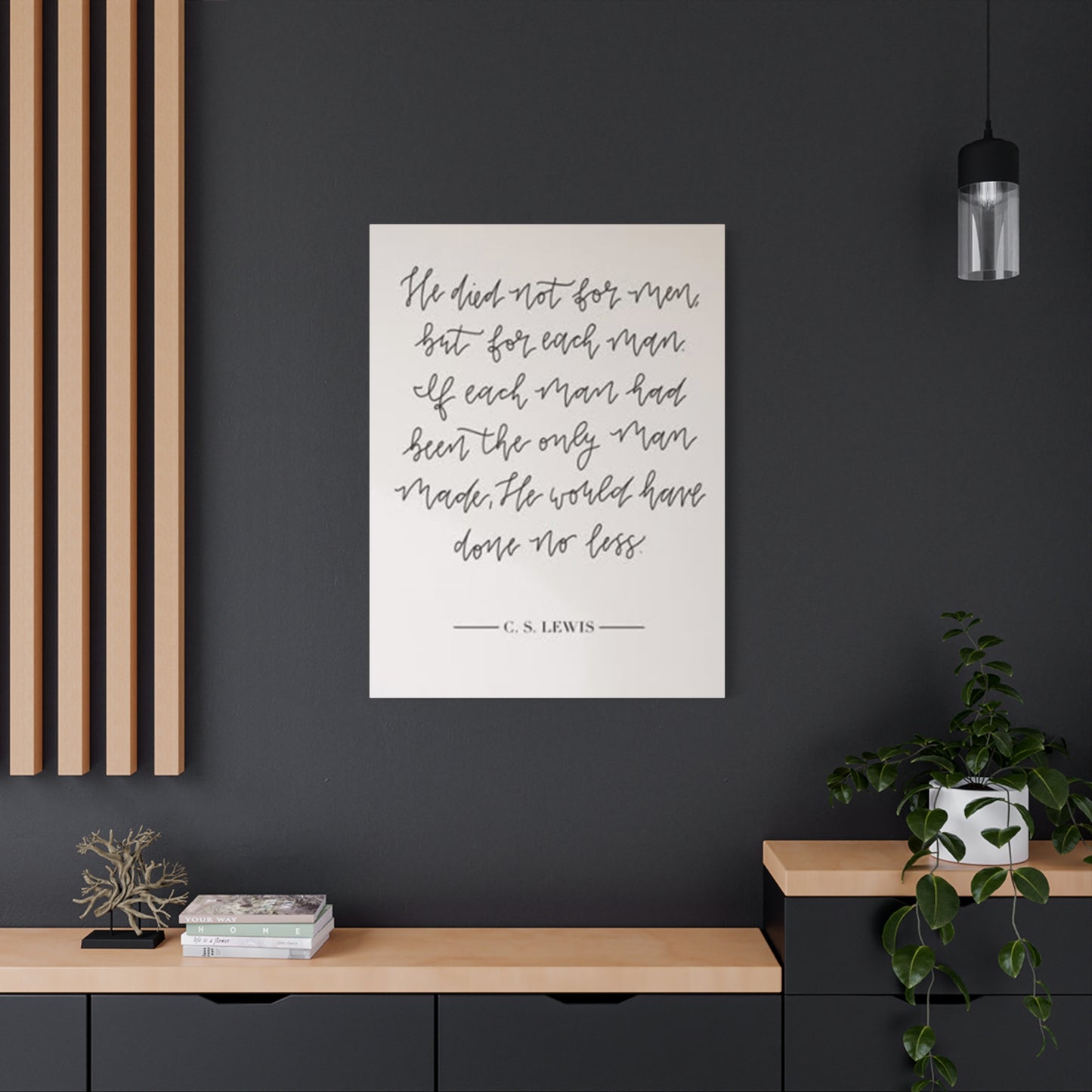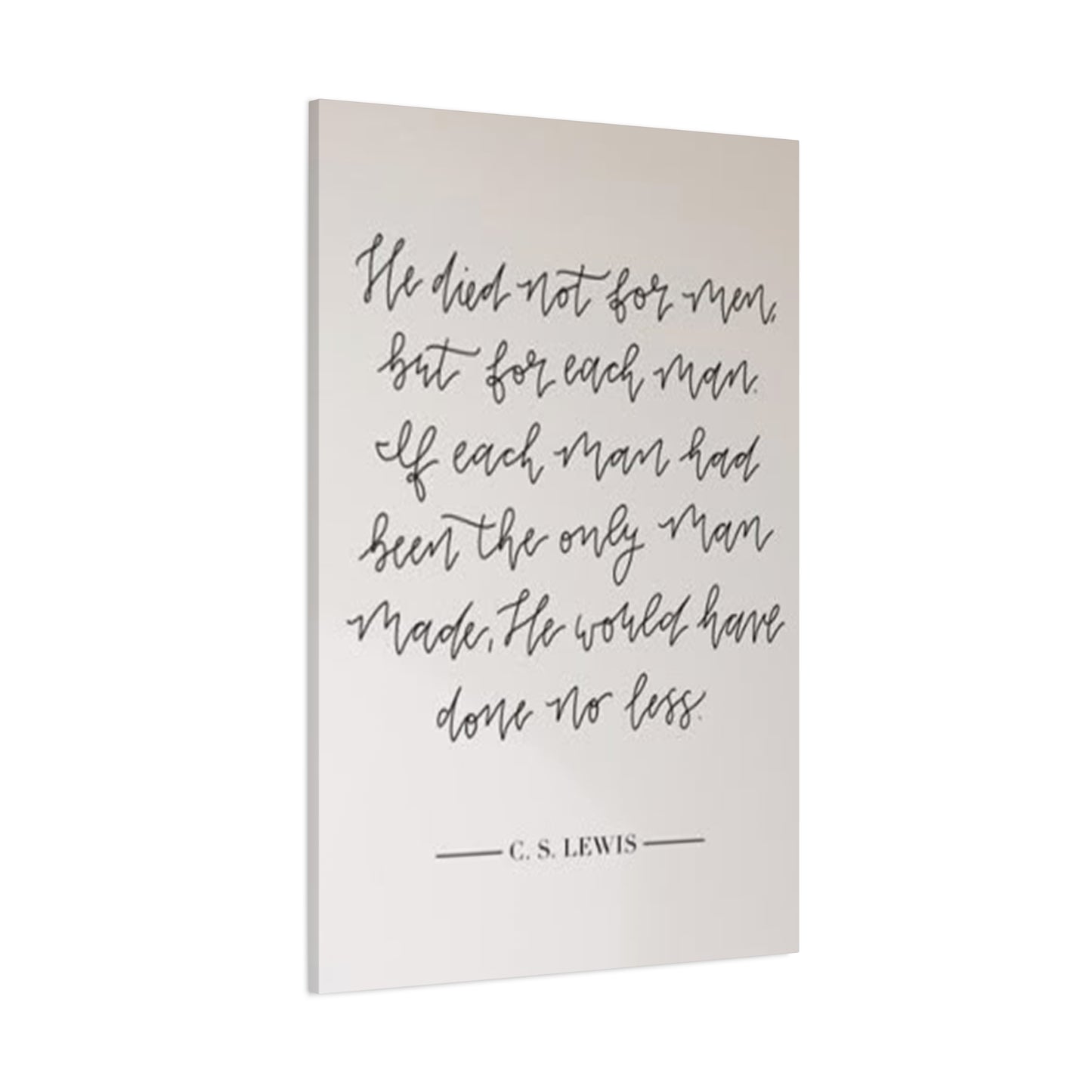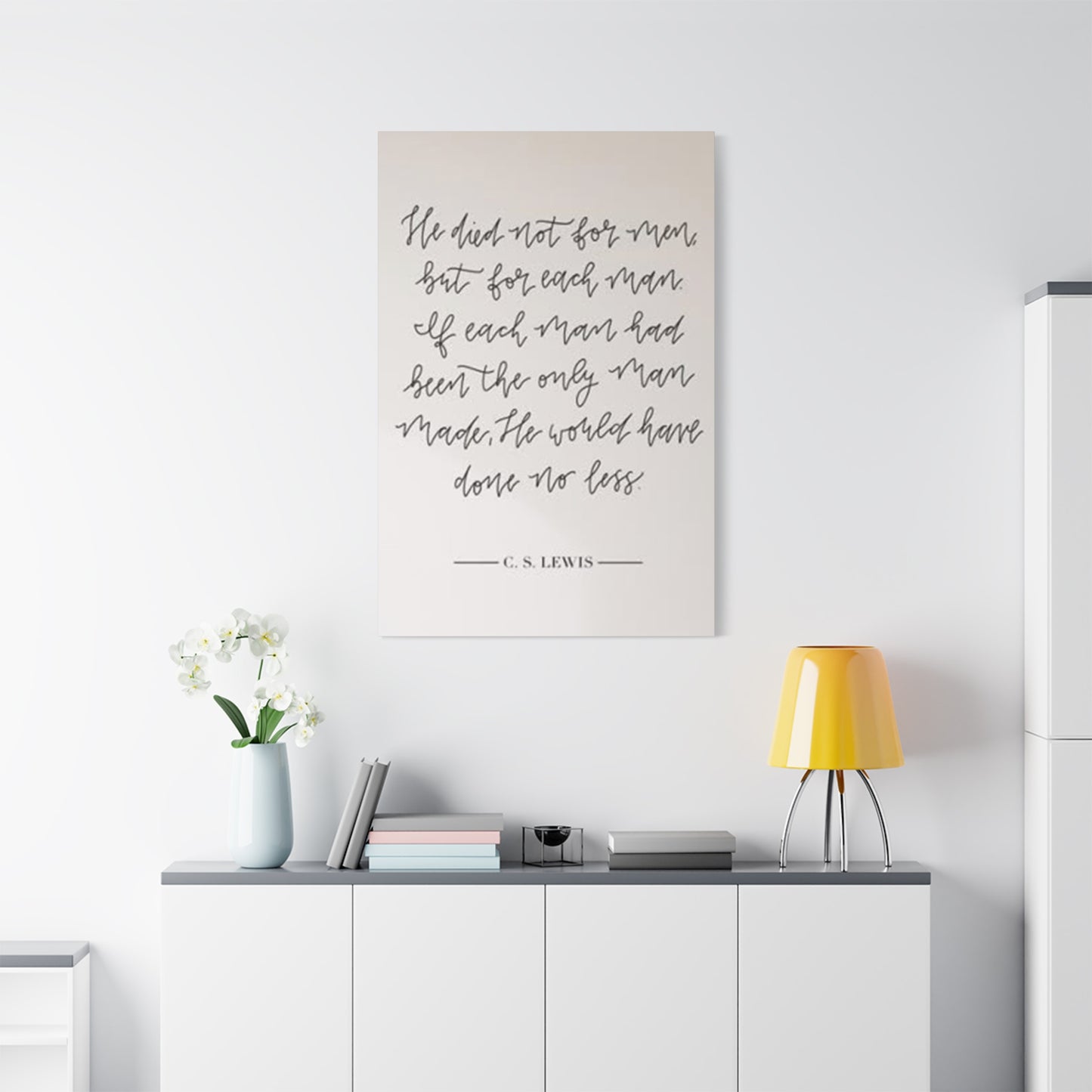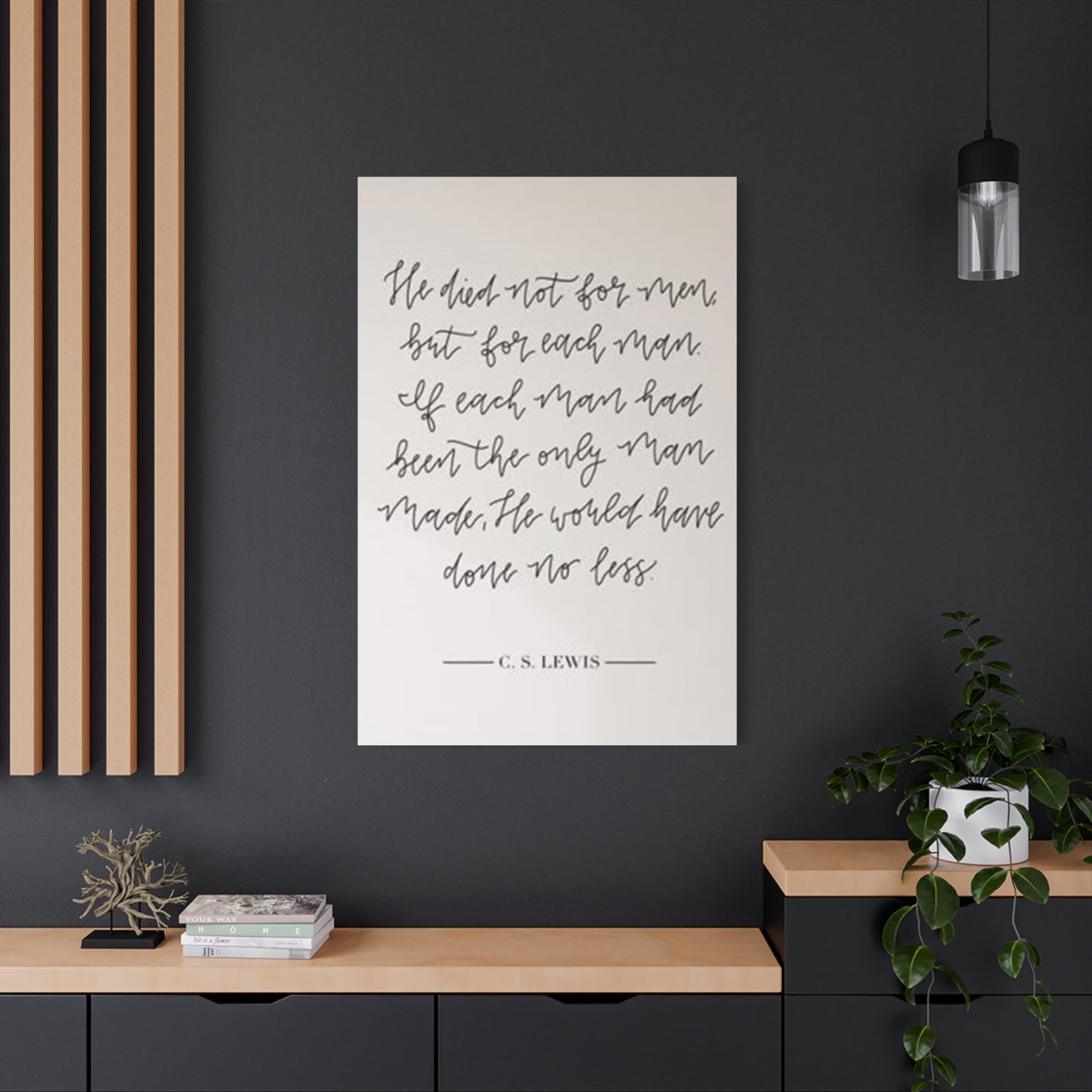C. S. Lewis Quote Wall Art & Canvas Prints
C. S. Lewis Quote Wall Art & Canvas Prints
Couldn't load pickup availability
Inspiring Literary Décor: Bringing Timeless Wisdom into Your Living Spaces with C. S. Lewis Quote Wall Art
The art of displaying meaningful words within our homes has evolved into something far more profound than mere decoration. When we consider the impact of thoughtfully chosen phrases adorning our walls, we recognize their power to shape atmospheres, influence moods, and spark contemplative moments throughout our daily routines. Among the vast collection of literary figures whose wisdom deserves prominent placement in our domestic sanctuaries, one particular author stands distinguished through his remarkable ability to capture eternal truths within eloquent sentences.
The significance of incorporating wisdom from celebrated thinkers into our living environments cannot be overstated. These carefully selected expressions serve multiple purposes simultaneously, functioning as aesthetic enhancements while providing continuous sources of reflection and encouragement. The residence transforms into more than simply a shelter when embellished with words that resonate deeply with our personal philosophies and aspirations.
Discovering the Profound Impact of Literary Wisdom in Modern Interior Spaces
Contemporary dwelling spaces increasingly reflect the personalities and values of their inhabitants through carefully curated decorative choices. The transition from generic, mass-produced artwork toward personalized expressions of belief and conviction marks a significant shift in how individuals approach their domestic environments. This movement toward meaningful decoration stems from a growing awareness that our surroundings profoundly affect our mental states, productivity levels, and overall sense of wellbeing.
When examining the phenomenon of displaying quotations within residential and commercial settings, we observe a fascinating intersection between literary appreciation and interior design principles. The strategic placement of thought-provoking statements creates focal points that draw attention while simultaneously inviting deeper engagement. Unlike purely visual artwork that communicates through color and form alone, textual displays engage the intellectual faculties, prompting readers to pause and contemplate the messages presented.
The selection of which particular author's words to feature represents a deeply personal decision that reveals much about the homeowner's intellectual interests and spiritual inclinations. Among the countless writers, philosophers, and thinkers whose words grace countless walls, certain figures possess a unique capacity to speak across generational boundaries and cultural divides. Their observations about existence, morality, courage, and meaning maintain relevance regardless of changing social contexts or evolving aesthetic preferences.
Creating spaces that nurture both body and spirit requires attention to elements that extend beyond functional necessity or visual appeal. The atmosphere generated by surrounding ourselves with uplifting, challenging, or comforting words contributes to an environment conducive to reflection, growth, and tranquility. This understanding drives many to seek out phrases that encapsulate principles they wish to remember, values they strive to embody, or perspectives they find illuminating.
Exploring the Lasting Relevance of Mid-Twentieth Century Literary Brilliance
The mid-1900s produced numerous writers whose contributions continue shaping contemporary discourse across various domains. Within this remarkable cohort, certain individuals demonstrated exceptional ability to articulate complex philosophical and spiritual concepts with clarity and grace. Their works transcended the immediate circumstances of their creation, speaking to universal human experiences and questions that persist through changing eras.
One particularly influential figure from this period combined scholarly rigor with imaginative storytelling, producing works that appealed simultaneously to intellectual curiosity and emotional depth. His writings addressed fundamental questions about meaning, morality, suffering, joy, and the nature of existence itself. The accessibility of his prose allowed profound ideas to reach audiences far beyond academic circles, democratizing wisdom that might otherwise remain confined to specialized discourse.
The breadth of this author's output encompassed multiple genres and formats, from allegorical fiction to apologetic argumentation, from literary criticism to personal correspondence. This versatility demonstrated remarkable intellectual range while maintaining consistent thematic concerns throughout diverse stylistic approaches. The cohesion underlying this varied body of work stems from a unified worldview that informed every sentence, regardless of the specific subject matter being addressed.
Contemporary readers continue discovering and rediscovering these writings, finding fresh relevance in observations penned decades ago. The enduring appeal lies partly in the author's gift for expressing timeless truths through memorable phrasing. Many sentences achieve a concise elegance that makes them particularly suitable for display, condensing complex thoughts into formats perfectly suited for contemplation during brief encounters throughout daily life.
Understanding Why Certain Writers' Words Resonate Across Generations and Cultures
The phenomenon of certain authors achieving lasting prominence while others fade into obscurity involves numerous factors beyond mere literary skill. While technical proficiency certainly matters, the writers who continue influencing readers decades or centuries after their deaths typically possess additional qualities that transcend craftsmanship. These include the ability to address universal human concerns, articulate experiences recognizable across diverse contexts, and express insights that maintain validity despite changing circumstances.
Examining the characteristics that enable particular writers to achieve this enduring relevance reveals several common elements. First, these authors typically grapple with fundamental questions rather than ephemeral issues. While they may address contemporary concerns, they do so in ways that illuminate underlying principles applicable beyond their immediate contexts. This universality allows subsequent generations to discover continuing pertinence within works originally composed for different audiences.
Second, truly influential writers demonstrate remarkable clarity of expression. Complex ideas become accessible through precise language and apt illustrations that help readers grasp concepts that might otherwise remain abstract. This communicative effectiveness distinguishes genuinely important thinkers from those whose insights remain trapped within impenetrable prose. The democratization of wisdom through clear writing represents a profound service to humanity.
Third, lasting literary figures often possess the courage to articulate unfashionable truths or challenge prevailing assumptions. While conformity to contemporary opinions might generate immediate popularity, the writers who continue mattering are those willing to maintain unpopular positions or question widely accepted beliefs. This intellectual independence, combined with substantive reasoning supporting controversial claims, creates work that retains interest long after initial publication.
The specific author whose words inspire countless C. S. Lewis quote wall art pieces exemplifies all these characteristics. His willingness to defend unpopular convictions, combined with exceptional communicative abilities and focus on perennial human concerns, produced a body of work that continues growing in influence rather than diminishing with time. The quotability of his writing makes it particularly suitable for display purposes, as individual sentences often encapsulate complete thoughts worthy of sustained meditation.
Examining the Diverse Range of Themes Found in Memorable Literary Expressions
The variety of subjects addressed within any prolific author's complete works provides abundant material for those seeking meaningful decorative text. This particular writer explored numerous themes throughout his extensive output, creating potential connections with readers possessing varied interests and concerns. The multiplicity of available quotations ensures that individuals can find expressions resonating with their specific circumstances, personalities, or aspirations.
Among the most frequently featured topics are observations about courage and perseverance during challenging circumstances. These expressions acknowledge the reality of difficulty while encouraging sustained effort and maintaining hope. The balance between realism and optimism within such statements makes them particularly valuable for those facing obstacles or navigating uncertain situations. Rather than offering empty platitudes, these quotations provide substantive encouragement grounded in authentic understanding of struggle.
Another prevalent theme involves reflections on love, friendship, and human connection. These passages explore the nature of genuine relationships, distinguishing superficial associations from bonds possessing real depth and significance. The insights offered help readers evaluate their own connections while aspiring toward more authentic and meaningful interactions. In an era characterized by widespread loneliness despite constant connectivity, such wisdom addresses urgent contemporary needs.
Contemplations on faith, doubt, and spiritual seeking constitute another major thematic category. These expressions acknowledge the legitimacy of questioning while offering perspectives that many find intellectually satisfying and emotionally comforting. The philosophical depth underlying these statements appeals to thoughtful individuals unwilling to accept simplistic answers yet desiring something beyond pure skepticism. This nuanced approach to profound questions demonstrates rare intellectual honesty.
Observations about literature, storytelling, and imagination form yet another significant theme. These quotations celebrate the power of narrative and creative expression while exploring how fictional worlds illuminate actual existence. For book lovers and creative individuals, such statements validate their passions while articulating why these pursuits matter beyond mere entertainment. The recognition of beauty's importance alongside practical concerns addresses holistic human flourishing.
Reflections on suffering, grief, and loss provide comfort and perspective to those navigating painful experiences. Rather than minimizing anguish or offering false consolation, these passages acknowledge pain's reality while suggesting frameworks for making sense of suffering. The hard-won wisdom evident in such expressions comes from personal experience rather than detached theorizing, lending authenticity that readers instinctively recognize and appreciate.
Discovering How Meaningful Text Transforms Ordinary Rooms into Sanctuaries of Reflection
The strategic placement of significant words throughout living spaces creates multiple opportunities for beneficial encounters throughout daily routines. Unlike books that require deliberate attention, displayed quotations enter consciousness during routine activities, their messages registering even during moments when focused reading seems impossible. This ambient presence allows important ideas to permeate awareness gradually, shaping thought patterns through repeated exposure.
Consider the experience of encountering an encouraging phrase while preparing morning coffee. The few seconds required to read and absorb the statement might shift one's entire outlook for the coming day, providing perspective or motivation that influences subsequent choices and reactions. This subtle yet powerful impact illustrates why thoughtfully selected wall text constitutes more than mere decoration. These displays function as daily reminders of values, aspirations, and truths easily forgotten amid life's distractions.
The dining area offers particularly rich potential for meaningful textual displays. Meals often serve as occasions for conversation and connection, making this space ideal for phrases that prompt reflection or discussion. A well-chosen quotation can spark conversations that deepen relationships, as family members or guests share their interpretations and responses to the displayed words. This social dimension transforms C. S. Lewis quote wall art from private meditation aids into catalysts for communal exploration of significant topics.
Bedroom environments benefit from expressions promoting peace, gratitude, or hope. The last thoughts before sleep and first impressions upon waking significantly impact mental states and emotional wellbeing. Surrounding sleeping spaces with words that encourage positive perspectives or remind residents of enduring truths creates supportive atmospheres conducive to rest and renewal. The intimate nature of bedrooms makes them particularly appropriate for personally meaningful selections that might not suit more public areas.
Home offices and study spaces thrive when embellished with quotations related to perseverance, creativity, or purpose. These work-oriented environments often become sites of frustration or discouragement when projects prove difficult or progress seems inadequate. Strategic placement of wisdom addressing these common challenges provides readily accessible encouragement precisely when needed most. The presence of such reminders can prevent abandonment of worthwhile endeavors during inevitable moments of difficulty.
Children's rooms present unique opportunities for age-appropriate expressions that instill positive values and perspectives from early ages. Young minds absorb messages from their environments, making the selection of displayed text in these spaces particularly consequential. Quotations celebrating curiosity, kindness, courage, or wonder contribute to character formation while creating visually interesting decorative elements. As children mature, their ability to engage with more complex ideas grows, allowing displays to evolve alongside their developing capacities.
Investigating Various Formats and Materials for Displaying Inspirational Literary Excerpts
The explosion of interest in meaningful textual displays has generated remarkable diversity in available formats and materials. This variety ensures that individuals can find options harmonizing with existing décor styles while satisfying practical considerations like budget constraints and installation preferences. Understanding the characteristics of different approaches enables informed decisions that maximize both aesthetic appeal and longevity.
Traditional framed prints remain perpetually popular, offering classic elegance suitable for virtually any interior style. The frame provides both protection and visual definition, creating clear boundaries that draw attention to the enclosed text. Material choices for the print itself range from standard paper to higher-quality cardstock or even fabric. The framing options span from simple wooden borders to elaborate gilded designs, allowing customization matching specific aesthetic preferences and budgets.
Canvas prints have gained substantial popularity in recent decades, offering texture and dimensionality that flat prints cannot match. The slightly three-dimensional quality creates shadow effects that add visual interest while maintaining clean, modern aesthetics. Canvas naturally suits contemporary and casual settings, though appropriate color schemes and typography can adapt this format to more traditional environments. The stretched canvas format eliminates the need for separate framing, simplifying installation while potentially reducing costs.
Wooden signs provide rustic charm particularly compatible with farmhouse, cottage, or country-inspired interiors. The natural material brings organic warmth to spaces while offering substantial durability. Wooden displays range from rough-hewn boards with deliberately distressed appearances to smooth, precisely manufactured plaques with professional lettering. The versatility of wood allows both primitive aesthetics and refined presentations depending on finish and execution quality.
Metal signs introduce industrial elements that complement modern, minimalist, or eclectic décor schemes. The material's inherent durability makes metal particularly suitable for high-traffic areas or spaces where less robust options might suffer damage. Finishes vary widely, from brushed aluminum's subtle sheen to powder-coated steel's bold coloration. The contemporary associations of metal displays make them especially popular among younger demographics attracted to urban design sensibilities.
Vinyl wall decals offer maximum flexibility, allowing direct application to painted walls without permanent commitment. This removable format appeals particularly to renters or those who frequently refresh their décor. The ability to position lettering precisely as desired enables creative arrangements impossible with pre-formatted displays. Size options range from modest phrases suitable for small spaces to expansive statements spanning entire walls. The variety of available colors ensures compatibility with diverse color schemes.
Acrylic displays provide contemporary sophistication through transparent or translucent materials that seem to float when mounted with standoffs. The modern aesthetic suits minimalist interiors while drawing attention through novel presentation rather than traditional framing. Light interaction with acrylic creates subtle visual effects that change with viewing angles and illumination conditions. This premium option typically commands higher prices but delivers distinctive appearance difficult to achieve through other means.
Navigating the Selection Process for Personalized Literary Displays in Your Home
Choosing which specific quotations to feature requires thoughtful consideration of multiple factors. The decision involves balancing personal preferences, aesthetic considerations, practical constraints, and intended purposes. A systematic approach to this selection process increases the likelihood of satisfaction with final choices while preventing impulsive decisions that might prove regrettable.
Begin by identifying themes or topics holding particular significance in your life currently. Are you navigating challenges requiring encouragement? Experiencing joy worth celebrating? Contemplating profound questions? Seeking reminders of important priorities? The answers to such questions help narrow the vast universe of potential quotations to manageable subsets aligned with present needs and circumstances. This thematic focusing prevents overwhelming paralysis when confronted with countless appealing options.
Consider the intended location for each display, as spatial context significantly influences what works effectively. Large, bold statements suit spacious walls with minimal competing visual elements, while modest phrases better complement busier environments or smaller areas. The room's function also matters—expressions appropriate for private bedrooms might seem overly intimate in public entertaining spaces, while statements suitable for living rooms might lack the personal resonance desired in more private quarters.
Evaluate how potential selections interact with your existing décor style. While contrast can create interesting tension, excessive clash produces visual discord that diminishes both the displayed text and surrounding elements. Typography style carries significant aesthetic implications—elegant script conveys different impressions than bold sans-serif lettering. Color schemes should harmonize with existing palettes unless deliberate contrast serves specific purposes. These design considerations ensure that C. S. Lewis quote wall art enhances rather than detracts from overall interior coherence.
Assess the enduring relevance of potential quotations versus time-bound applicability. While selecting expressions addressing immediate circumstances proves tempting, displays typically remain in place for extended periods. Choosing statements with lasting pertinence prevents situations where displays become outdated as life circumstances evolve. This doesn't preclude selecting motivational phrases relevant to current challenges, but suggests balancing such selections with timeless observations maintaining relevance regardless of changing situations.
Research the context surrounding appealing quotations to ensure accurate understanding and comfortable endorsement of their complete meanings. Isolated sentences sometimes convey impressions inconsistent with surrounding text or the author's broader perspectives. Verifying that partial quotations accurately represent intended meanings prevents inadvertently displaying misrepresentations. This diligence demonstrates respect for both the original author and potential viewers who might know the broader context.
Consider how potential displays might facilitate conversations with visitors. Quotations often spark discussions about their meanings, implications, or the experiences that make them resonate. Selecting expressions you genuinely wish to explore with others creates opportunities for meaningful exchanges, while choosing statements primarily for aesthetic reasons might prove awkward if guests inquire about their significance. This social dimension adds value beyond private meditation, transforming displays into conversation starters that deepen relationships.
Analyzing the Psychological Benefits of Surrounding Yourself with Uplifting Words
The impact of environmental factors on mental states has received increasing attention from researchers across various disciplines. These investigations confirm what intuition suggests—our surroundings significantly influence thoughts, emotions, and behaviors. Understanding these mechanisms illuminates why deliberate curation of domestic environments, including textual displays, represents worthwhile investment in wellbeing rather than frivolous indulgence.
Repeated exposure to specific messages creates cognitive pathways that strengthen with each encounter. This phenomenon, known as priming, means that regularly viewing certain statements increases the likelihood of accessing related concepts and attitudes when facing relevant situations. For instance, frequent exposure to expressions about courage and perseverance makes these qualities more mentally accessible during challenging circumstances, potentially influencing responses and choices. This subtle yet cumulative effect demonstrates how ambient textual environments shape character over time.
Visual reminders of core values and priorities serve crucial functions amid life's inevitable distractions and competing demands. The barrage of messages from media, advertising, and social pressures constantly threatens to displace personal convictions with external agendas. Deliberately placed quotations reflecting authentic commitments provide anchors preventing drift away from genuine priorities. These displays function as physical manifestations of internal compasses, helping maintain orientation despite disorienting circumstances.
The practice of pausing to read and contemplate displayed wisdom introduces brief moments of mindfulness into otherwise harried routines. These micro-meditations, though lasting mere seconds, accumulate significant beneficial effects over time. The mental shift from task-focused productivity to reflective consideration, however brief, provides respite from relentless doing that characterizes much contemporary existence. Regular engagement with thought-provoking statements cultivates habits of reflection that enrich inner lives.
Aesthetic pleasure derived from beautiful presentation of meaningful words generates positive emotional responses that contribute to overall wellbeing. The combination of visual appeal and intellectual substance creates particularly satisfying experiences engaging multiple dimensions of human consciousness simultaneously. This holistic engagement distinguishes textual displays from purely decorative elements lacking conceptual depth or merely functional text lacking aesthetic consideration. The integration of beauty and meaning addresses multiple aspects of flourishing existence.
For individuals struggling with negative self-talk or destructive thought patterns, strategically selected quotations can provide alternative narratives countering harmful internal dialogues. Regularly encountering statements affirming worth, capability, or hope creates competition for mental space otherwise monopolized by criticism and despair. While textual displays alone cannot resolve serious mental health challenges, they function as supportive elements within broader efforts toward healthier cognitive patterns. This modest but meaningful contribution makes such environmental modifications worthwhile components of self-care practices.
The sense of identity affirmation that comes from surrounding oneself with expressions of personal philosophy should not be underestimated. Seeing one's beliefs and values reflected in one's environment creates feelings of congruence and authenticity. This external manifestation of internal convictions strengthens commitment to those principles while communicating them to others. The psychological benefits of living in alignment with professed beliefs extend across multiple dimensions of wellbeing, from reduced cognitive dissonance to increased confidence in decision-making.
Exploring Creative Placement Strategies for Maximum Visual and Emotional Impact
The location and arrangement of textual displays significantly influence their effectiveness as both decorative elements and sources of inspiration. Thoughtful placement maximizes beneficial encounters while ensuring aesthetic integration with existing spatial compositions. Understanding basic design principles alongside practical considerations enables strategic decisions that optimize multiple objectives simultaneously.
Eye-level positioning ensures maximum readability and engagement, as displays placed too high or low often escape notice or require uncomfortable viewing angles. The standard guideline suggests centering artwork approximately 57 to 60 inches from the floor, though this requires adjustment based on ceiling heights and surrounding elements. The goal involves creating natural visual relationships where displays integrate logically within sightlines rather than demanding awkward attention-seeking.
Creating gallery walls combining multiple pieces generates dynamic visual interest while allowing thematic exploration through varied selections. This approach works particularly well in larger spaces where single pieces might seem inadequate or lost. The arrangement of multiple elements offers opportunities for creative expression through varied sizes, frames, and orientations. Successful gallery walls require careful planning regarding spacing and relationships between pieces, but achieve impressive results when executed thoughtfully.
Unexpected locations often prove surprisingly effective for textual displays. Hallways, stairwells, and other transitional spaces typically receive minimal decorative attention despite regular use. Placing meaningful quotations in these overlooked areas transforms previously neglected spaces while creating surprise encounters that refresh familiar environments. The element of discovery adds to the pleasure of encountering these displays, preventing the invisibility that sometimes affects permanently positioned décor.
Consideration of natural lighting dramatically affects both visibility and aesthetic quality of displays. Positions receiving abundant daylight showcase colors and details beautifully while creating changing appearances as light shifts throughout days. However, direct sunlight exposure risks fading certain materials over time, particularly paper-based prints. Balancing these competing concerns requires assessing specific circumstances and choosing materials appropriate for intended locations.
Grouping thematically related quotations creates cohesive narratives within particular spaces. For instance, collecting multiple expressions about gratitude or contentment in a breakfast nook reinforces those attitudes during morning routines. Similarly, assembling courage and perseverance-themed pieces in workout spaces provides encouragement precisely when physical or mental fatigue might tempt quitting. This strategic thematic clustering amplifies individual pieces' impact through mutual reinforcement.
Mixing textual displays with complementary visual artwork creates rich, layered environments engaging multiple senses and cognitive faculties. The interplay between images and words adds complexity and interest impossible with either element alone. This integration requires attention to stylistic coherence and thematic compatibility, but succeeds in generating sophisticated environments reflecting thoughtful curation rather than haphazard accumulation.
Addressing Common Concerns About Displaying Inspirational Literary Quotes
Despite widespread enthusiasm for meaningful textual displays, some individuals hesitate due to various concerns or uncertainties. Addressing these common reservations directly helps potential enthusiasts move past obstacles preventing them from enjoying the benefits these decorative elements provide. Many worries dissolve when examined closely or prove easily manageable through straightforward solutions.
Fears about appearing pretentious or self-righteous through displaying philosophical or spiritual statements prevent some from pursuing otherwise appealing options. This concern reflects legitimate awareness that ostentatious virtue-signaling alienates rather than inspires. However, the motivation behind selections matters more than the fact of display itself. Genuine desire for personal growth and environmental enrichment differs substantially from performative demonstrations of supposed superiority. Choosing quotations that resonate authentically rather than those calculated to impress others resolves this concern.
Worries about permanently committing to specific selections given changing life circumstances prove valid but manageable. The solution involves embracing impermanence and recognizing that updating displays as situations evolve constitutes a feature rather than a flaw. Rotating quotations periodically prevents both visual staleness and message irrelevance. This flexibility allows environments to grow alongside inhabitants rather than becoming static time capsules of past interests or needs. Various mounting methods facilitate easy changes, from removable adhesive strips to simple frame exchanges.
Uncertainty about selecting "the right" quotations sometimes creates paralyzing indecision. The vast number of available options, combined with permanence concerns, makes choosing feel overwhelming. Recognizing that no selection is irrevocably wrong helps overcome this barrier. Preferences evolve naturally, and what resonates today need not remain relevant indefinitely. Starting with one or two carefully chosen pieces proves less daunting than attempting comprehensive room transformations immediately. Gradual accumulation allows learning through experience what works in specific spaces and situations.
Budget concerns constitute legitimate practical considerations, particularly when quality materials and professional framing can become expensive. However, meaningful displays need not require substantial financial investment. Numerous affordable options exist, from printable designs for home printing to inexpensive ready-made pieces from various retailers. The value derived from beneficial environmental modifications often justifies modest expenditures, making this accessible even on limited budgets. DIY approaches using basic materials offer further cost-reducing possibilities without sacrificing quality or impact.
Questions about maintaining appropriate tones in shared living spaces arise when household members possess different preferences or beliefs. Negotiating these situations requires communication and compromise, ensuring no residents feel uncomfortable in their own homes. Selecting quotations with broad appeal addressing universal rather than divisive themes often resolves potential conflicts. Designating certain spaces for individual expression while maintaining neutral tones in common areas represents another viable approach. Mutual respect and collaborative decision-making prevent decoration from becoming sources of domestic tension.
Skepticism about whether textual displays genuinely provide substantive benefits or merely constitute trendy decoration deserves honest examination. While placebo effects and confirmation bias certainly influence perceptions, considerable evidence supports the real impact of environmental factors on psychological states. Even accounting for potential overestimations, the combination of aesthetic pleasure, mindfulness prompts, and value reinforcement justifies the modest investments required. Approaching these practices with appropriate expectations—recognizing them as supportive elements rather than magical solutions—maintains realistic perspectives.
Investigating the Craftsmanship Behind High-Quality Literary Wall Displays
Understanding what distinguishes superior products from mediocre offerings empowers consumers to make informed purchasing decisions aligned with quality expectations and budget realities. Various factors contribute to overall quality, from material selection through manufacturing processes to finishing details. Familiarity with these considerations enables evaluation of options beyond superficial appearances or marketing claims.
Typography quality represents perhaps the most immediately noticeable distinguishing factor. Professional designs feature carefully selected fonts with appropriate character for the quotation's content and emotional tone. Letter spacing, line height, and overall composition receive meticulous attention, resulting in legible, aesthetically pleasing presentations. Amateur designs often exhibit telltale signs like cramped spacing, awkward line breaks, or font choices clashing with message tone. The difference between professional and amateur typography becomes obvious when compared directly, even to untrained eyes.
Material quality directly impacts both appearance and longevity. Superior canvas displays use substantial, properly primed fabric that maintains tautness over time without sagging or warping. Quality papers resist fading and deterioration when properly handled and displayed. Premium woods exhibit straight grain and smooth surfaces free from defects, while metal pieces feature even finishes without bubbling or thin spots. These material considerations significantly affect satisfaction throughout ownership periods.
Printing quality determines how designs translate from digital files to physical products. High-resolution printing produces sharp edges and smooth color transitions without visible pixelation or banding. Color accuracy ensures that purchased items match digital previews, avoiding unpleasant surprises upon delivery. Inferior printing exhibits various telltale problems including oversaturation, muddiness, or visible dot patterns. Print quality particularly matters for designs incorporating subtle gradients or detailed graphic elements.
Construction methods influence structural integrity and longevity. Canvas stretching should create uniform tension without loose areas or excessive tightness causing distortion. Frame joints should fit precisely with no gaps or misalignments. Hanging hardware should attach securely with appropriate weight ratings for the piece. These structural considerations may not be immediately apparent but significantly impact long-term satisfaction and display safety.
Finishing touches separate exceptional pieces from merely adequate offerings. Attention to detail appears in elements like corner treatments, edge finishing, and protective coatings. Superior products exhibit consistent quality across all aspects, with no aspects appearing rushed or inadequate. These refinements, while subtle, contribute to overall impressions of quality and craftsmanship. The cumulative effect of many small excellence details creates products justifying premium pricing.
Customization capabilities allow personalization beyond standard offerings. Some providers offer modifications like alternative color schemes, size adjustments, or material substitutions. The ability to adapt designs to specific requirements increases the likelihood of achieving perfect solutions for particular spaces and preferences. This flexibility particularly benefits those with unusual spatial constraints or specific aesthetic requirements not addressed by standard options.
Examining the Ethical Considerations in Displaying Authors' Words
The practice of displaying quotations raises certain ethical questions deserving thoughtful consideration. Engaging with these concerns demonstrates respect for intellectual property, authorial intent, and the broader literary community. While displaying inspirational phrases generally constitutes acceptable use, understanding relevant principles ensures practices remain within appropriate bounds.
Proper attribution represents fundamental courtesy when displaying others' words. Identifying the source allows viewers to explore broader contexts and discover additional works by the author. This practice also prevents inadvertent plagiarism or misattribution that might mislead viewers about statements' origins. Most commercial products include appropriate attribution, but DIY creators should ensure they acknowledge sources clearly. The convention typically involves including the author's name prominently alongside or beneath the quotation itself.
Accuracy in quotation reproduction ensures faithfulness to original texts. Altering wording, even inadvertently through transcription errors, potentially misrepresents authors' intended meanings. Verifying quotations against authoritative sources before display prevents perpetuating inaccuracies that circulate widely despite being incorrect. This diligence respects authors' craftsmanship while ensuring displays convey what creators actually wrote rather than corrupted versions.
Context consideration prevents problematic decontextualization. While individual sentences often work effectively as standalone statements, occasionally removing phrases from surrounding text distorts meanings significantly. Ensuring that isolated quotations accurately represent authors' positions rather than creating misleading impressions through selective excerpting demonstrates intellectual honesty. This requires examining not just immediate sentence contexts but authors' broader philosophical frameworks.
Copyright awareness prevents illegal reproduction of protected texts. While short quotations typically fall under fair use provisions, particularly for personal non-commercial purposes, distributing copyrighted material or using it for profit might violate intellectual property rights. Commercial manufacturers presumably secure appropriate permissions, but individuals creating custom displays should understand relevant limitations. Most concerns about personal home displays prove unfounded, but awareness prevents inadvertent violations.
Respectful representation of authors whose worldviews we find appealing matters particularly when those figures hold controversial positions on certain issues. Selective quotation might create impressions of complete agreement where only partial alignment exists. Honest engagement acknowledges complete contexts, including aspects we might find problematic, rather than sanitizing complex figures into perfectly palatable form. This intellectual honesty respects both authors and audiences.
Supporting legitimate creators through appropriate purchasing channels rather than pirated designs protects artists and designers who invest effort producing quality products. The availability of stolen designs at artificially low prices tempts budget-conscious consumers but harms creative professionals struggling to sustain themselves. Purchasing from legitimate sources, even if slightly more expensive, ensures creators receive appropriate compensation for their work. This ethical consumption supports the continued production of quality offerings.
Discovering Complementary Practices That Enhance the Impact of Literary Wall Displays
While textual displays provide value independently, combining them with other practices amplifies their beneficial effects. These complementary activities create synergies where combined impact exceeds the sum of individual elements. Exploring various possibilities allows individuals to construct personalized approaches maximizing returns on environmental modification investments.
Regular journaling about reactions to displayed quotations deepens engagement beyond passive viewing. Writing about how particular statements resonate, what memories or thoughts they evoke, or how they relate to current circumstances transforms brief encounters into extended meditations. This practice creates permanent records of personal growth while sharpening abilities to articulate nuanced responses to complex ideas. The discipline of regular journaling itself yields substantial benefits, making this complement particularly valuable.
Memorization of favored quotations enables carrying their wisdom internally rather than depending on external displays. Committing meaningful statements to memory allows accessing their perspective and encouragement during situations when physical displays are unavailable. The mental effort required for memorization itself enhances retention and understanding, creating deeper relationships with selected texts. Reciting memorized quotations during challenges, uncertainty, or moments requiring perspective provides readily available internal resources.
Reading authors' complete works from which displayed quotations are drawn provides fuller understanding of ideas summarized in brief statements. This exploration reveals how individual sentences fit within broader intellectual projects while introducing additional concepts and perspectives worth contemplating. Many find that appealing quotations serve as gateways into extensive bodies of work they might not otherwise encounter. This expanded reading enriches understanding while potentially identifying additional quotation candidates.
Discussing displayed quotations with family members, friends, or guests transforms private reflection into shared exploration. These conversations reveal how different individuals interpret identical statements through varied experiences and perspectives. The resulting exchanges often illuminate dimensions of meaning that solitary contemplation might miss. This social dimension builds community around shared engagement with significant ideas while deepening relationships through substantive dialogue.
Creating personal artwork inspired by favorite quotations combines creative expression with textual engagement. Painting, drawing, collage, or other artistic responses provide alternative modes of processing and responding to written words. This creative engagement appeals particularly to visually oriented individuals who relate to concepts better through images than pure text. The resulting original artworks become deeply personal items impossible to purchase commercially.
Incorporating quotations into meditation or contemplative prayer practices harnesses their potential for spiritual depth. Using meaningful statements as focal points for extended reflection allows ideas to penetrate beyond intellectual assent into deeper consciousness levels. This contemplative engagement differs from quick readings during daily activities, creating space for profound encounters with wisdom contained in brief phrases. Regular contemplative practice using selected quotations cultivates internal transformation extending far beyond aesthetic environmental improvements.
Investigating Seasonal and Occasional Rotations of Displayed Literary Wisdom
The practice of periodically changing displayed quotations offers multiple advantages while introducing variety preventing visual staleness. This rotation keeps environments dynamic and responsive to evolving circumstances rather than static and unchanging. Developing systematic approaches to rotation maximizes benefits while preventing the neglect that sometimes affects periodically changing elements.
Seasonal transitions provide natural occasions for refreshing textual displays. Quotations celebrating growth and renewal suit spring environments, while observations about abundance and gratitude complement autumn atmospheres. Winter-appropriate selections might address themes of rest, reflection, or hope during darkness, while summer displays could celebrate joy, adventure, or leisure. These seasonal alignments create harmony between interior environments and external natural cycles.
Holidays and celebrations offer opportunities for temporarily installing themed quotations relevant to specific occasions. Birthday displays might feature reflections on growth, wisdom, or gratitude for another year lived. Anniversary quotations could explore themes of commitment, love, or shared journeys. Holiday-specific selections celebrate particular traditions or values associated with commemorated events. These temporary installations mark significant moments while maintaining flexibility to return to standard displays afterward.
Personal milestone moments deserve acknowledgment through appropriate quotation selections. Beginning new jobs, relocating to different cities, starting educational programs, or embarking on major projects could each inspire relevant textual displays. These personalized markers create environmental acknowledgments of significant life transitions while providing encouragement tailored to specific challenges or opportunities. The practice transforms decoration into biographical documentation of personal journeys.
Monthly themes create manageable rotation schedules preventing both excessive changing and prolonged staleness. Selecting twelve quotations addressing different topics allows annual cycles where each statement receives approximately month-long display periods. This approach balances stability with variety while creating anticipation around upcoming changes. The monthly rhythm also facilitates planning and preparation, making rotation more likely to actually occur rather than being perpetually postponed.
Mood-responsive changes allow environments to reflect and influence emotional states. During particularly challenging periods, installing encouraging or strengthening quotations provides needed support. Times of joy and success might inspire grateful or celebratory selections. This responsive approach requires maintaining collections of varied statements suitable for different circumstances, allowing quick installation of contextually appropriate options. The flexibility to adapt environments to present needs maximizes their supportive potential.
Documentary photography of rotated displays creates visual records of how environments evolve over time. These images capture both the quotations themselves and surrounding decorative contexts, preserving memories of particular periods and configurations. Reviewing these photographic archives often proves surprisingly nostalgic, with particular arrangements triggering recollections of associated life circumstances. This documentation adds depth to what might otherwise be temporary and forgotten arrangements.
Conclusion
The market for meaningful textual displays has expanded dramatically in recent years, with numerous providers offering varied products across diverse price points and quality levels. Understanding this commercial landscape helps consumers navigate options effectively while identifying reputable sources and avoiding problematic vendors. Market awareness enables informed purchasing decisions maximizing satisfaction while minimizing potential disappointments.
Large online marketplaces host numerous sellers offering both original designs and reproduced content. These platforms provide convenient access to vast selections with customer reviews offering insights into product quality and seller reliability. However, the sheer volume of options can overwhelm browsers, and quality varies dramatically between listings. Careful evaluation of seller ratings, product descriptions, and customer feedback helps identify trustworthy providers among numerous options. Price comparison across multiple sellers often reveals significant differences for similar items.
Specialized retailers focusing specifically on inspirational décor curate selections aligning with particular aesthetic sensibilities or thematic focuses. These shops typically offer higher average quality than general marketplaces, having established relationships with specific artists and manufacturers. The curated nature of their offerings simplifies browsing for customers seeking particular styles or themes. Premium pricing often reflects both superior quality and the convenience of pre-screened selections.
Independent artists and designers frequently sell through personal websites or creative platforms dedicated to handmade goods. Supporting these individual creators often yields distinctive pieces unavailable through mass-market channels while directly compensating working artists.
Share


